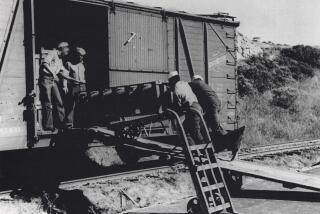Nuclear Risk Alleged in 1975 Ship Blasts
- Share via
WASHINGTON — A 1975 collision between two U.S. Navy ships in the Mediterranean triggered fires and explosions within 40 feet of nuclear weapons aboard one of the ships, two public interest groups charged Wednesday.
The commander of the Navy task force in the Mediterranean classified the incident as the most dangerous kind--what the Navy calls a “broken arrow” accident, one involving the possibility of detonation of nuclear weapons, the groups said. They said that the Navy covered up the accident report, which was submitted by Adm. Eugene Carroll, then commander of the U.S. Navy’s Task Force 60.
A copy of Carroll’s secret report was obtained and released to the press by the environmental group Greenpeace and the Washington-based Institute for Policy Studies, which plan to release a comprehensive report on naval accidents early next month.
The aircraft carrier John F. Kennedy and the cruiser Belknap collided during training maneuvers. Eight sailors were killed.
“The Navy has not only concealed the existence of nuclear weapons on the Belknap but has denied that a ‘broken arrow’ alert was issued in 1975,” charged Joshua Handler, a research coordinator for the Greenpeace Nuclear-Free Seas campaign. “Their record of public disclosure of naval accidents is as bad as their accident record itself.”
In the past, the Navy has acknowledged only one accident involving nuclear weapons aboard ships--a 1965 incident in which a nuclear bomb was lost off an aircraft carrier in the Pacific. Earlier this month, the two research groups revealed new details of the accident that they charged the Navy had concealed.
The Navy, sticking to longstanding policy, refused to confirm or deny the presence of nuclear weapons aboard the Belknap at the time of the collision. But a 1981 Defense Department report on accidents involving nuclear weapons from 1950 to 1980 does not list the Belknap-Kennedy disaster.
Navy Report Differs
In addition, a report by the Naval Nuclear Weapons Evaluation Facility states that “no accidents occurred” from 1975 to 1977.
“It is U.S. government policy neither to confirm nor deny the presence of nuclear weapons on ships, aircraft or U.S. military installations,” a Navy spokesman said. “That policy applied in 1975, as it does now.
“The Defense Department report from 1981 is correct in that no nuclear weapons were affected by the 1975 Belknap-John F. Kennedy collision and fire,” the spokesman added.
The public interest groups said that Carroll considered that conditions for a “broken arrow” alert had been satisfied.
In a message to his superiors on Nov. 22, 1975, Carroll warned of the “high probability that nuclear weapons on USS Belknap were involved in fire and explosions” after the collision.
“This is a classic case of definitional elasticity,” said William Arkin, an analyst for the Institute for Policy Studies and one of the authors of the forthcoming report. “They downgraded the accident after it occurred because they didn’t want to admit that there were nuclear weapons aboard the ships, and then they used their ambiguous definitions (of nuclear accidents) to cover that up.
“We caught them with their bell-bottoms down,” Arkin added.
The collision occurred during a night naval maneuver 70 miles east of Sicily. The Belknap’s superstructure was sheared off by the Kennedy’s overhanging carrier deck, and the Navy spent $210 million to repair the cruiser, three times its original cost.
The Belknap’s forward missile compartment held up to 60 missiles, including nuclear-tipped Terrier anti-aircraft missiles and nuclear-tipped anti-submarine rockets. The Navy recently decided to discontinue the deployment of such short-range nuclear missiles aboard its ships on grounds of both safety and effectiveness.
More to Read
Sign up for Essential California
The most important California stories and recommendations in your inbox every morning.
You may occasionally receive promotional content from the Los Angeles Times.














